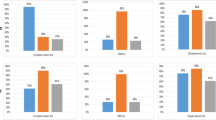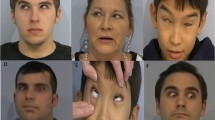Abstract
Background
Dystonic tics differ from clonic tics by their slower and more sustained nature. Dystonic tics are often present in patients with Tourette syndrome (TS) and other tic-disorders. However, their phenomenology and impact on overall impairment have not been extensively studied.
Materials and methods
We assessed clinical history and tic duration in video-recordings from patients with TS evaluated at our movement disorders clinic. Dystonic tics were defined as those lasting ≥ 1000 ms (ms).
Results
Of the total of 201 patients with TS, there were 156 with video-recordings suitable for tic duration analysis, of their tics, 57 (36.5%) of whom had dystonic motor tics, including 9 (5.7%) with dystonic phonic tics. Dystonic motor tics had a duration range between 1033 and 15,000 ms and dystonic phonic tics between 1132 and 17,766 ms. Patients with dystonic tics were older 24.4 vs. 16.5 years (P = 0.005) and had an older age at onset 12.9 vs. 7.2 years (P < 0.001), than patients without dystonic tics. The bivariate analysis showed an association between the presence of dystonic tics, greater tic severity and wider body distribution. The multivariate regression analysis showed a statistical association with older age at evaluation (P = 0.001), greater tic severity on video-recordings (P = 0.001) and co-occurrence with complex motor tics (P = 0.020). The presence of dystonic tics increased the risk for being considered for deep brain stimulation therapy, odds ratio: 15.7 (P = 0.002).
Conclusion
Dystonic tics, observed in about a third of patients with TS, are associated with increased severity of TS.


Similar content being viewed by others
Data availability
Available under reasonable request.
Code availability
Not applicable.
References
Jankovic J, Hallett M, Okun M, Comella C, Fahn S (2022) Principles and practice of movement disorders. Elsevier, 3rd edition Elsevier, Philadelphia, PA
Thenganatt MA, Jankovic J (2016) Recent advances in understanding and managing tourette syndrome. F1000Res 5:1000 (Faculty Rev-152)
Jankovic J (1991) Stone L (1991) dystonic tics in patients with Tourette’s syndrome. Mov Disord 6(3):248–252
Szejko N, Jakubczyk A, Dunalska A, Janik P (2019) Dystonic tics in patients with Gilles de la Tourette syndrome. Neurol Neurochir Pol 53:335–340
American Psychiatric Association (2013) Diagnostic and statistical manual of mental disorders. Author, Arlington, VA
Jankovic J, Kurlan R (2011) Tourette syndrome: evolving concepts. Mov Disord 26:1149–1156
Goetz CG, Pappert EJ, Louis ED, Raman R, Leurgans S (1999) Advantages of a modified scoring method for the rush video-based tic rating scale. Mov Disord 14:502–506
Sambrani T, Jakubovski E, Müller-Vahl KR (2016) New insights into clinical characteristics of Gilles de la Tourette syndrome: findings in 1032 patients from a single German center. Front Neurosci 10:415
Baizabal-Carvallo JF, Alonso-Juarez M, Jankovic J (2022) Self-injurious behavior in tourette syndrome. J Neurol 269:2453–2459.
Erro R, Martino D, Ganos C, Damasio J, Batla A, Bhatia KP (2014) Adult-onset primary dystonic tics: a different entity? Mov Disord Clin Pract 1:62–66
Patel N, Jankovic J, Hallett M (2014) Sensory aspects of movement disorders. Lancet Neurol 13:100–112
Ganos C, Neumann WJ, Müller-Vahl KR (2021) The phenomenon of exquisite motor control in tic disorders and its pathophysiological implications. Mov Disord 36:1308–1315
Billnitzer A, Jankovic J (2020) Current management of tics and Tourette syndrome: behavioral, pharmacologic, and surgical treatments. Neurotherapeutics 17:1681–1693
Albin RL, Koeppe RA, Wernette K et al (2009) Striatal [11C]dihydrotetrabenazine and [11C]methylphenidate binding in Tourette syndrome. Neurology 72:1390–1396
Caligiore D, Mannella F, Arbib MA, Baldassarre G (2017) Dysfunctions of the basal ganglia-cerebellar-thalamo-cortical system produce motor tics in Tourette syndrome. PLoS Comput Biol 13:e1005395
Maia TV, Conceição VA (2017) The roles of phasic and tonic dopamine in tic learning and expression. Biol Psychiat 82:401–412
Lerner A, Bagic A, Simmons JM et al (2012) Widespread abnormality of the γ-aminobutyric acid-ergic system in Tourette syndrome. Brain 135:1926–1936
Tinaz S, Malone P, Hallett M, Horovitz SG (2015) Role of the right dorsal anterior insula in the urge to tic in Tourette syndrome. Mov Disord 30:1190–1197
Kwak C, Dat Vuong K, Jankovic J (2003) Premonitory sensory phenomenon in Tourette’s syndrome. Mov Disord 18:1530–1533
Kano Y, Fujio M, Kaji N, Matsuda N, Nonaka M, Kono T (2020) Changes in sensory phenomena, tics, obsessive-compulsive symptoms, and global functioning of Tourette syndrome: a follow-up after four years. Front Psychiatry 11:619
Isaacs D, Riordan H (2020) Sensory hypersensitivity in Tourette syndrome: a review. Brain Dev 42:627–638
Pringsheim T, Freeman R, Lang A (2007) Tourette syndrome and dystonia. J Neurol Neurosurg Psychiatry 78:544
Damásio J, Edwards MJ, Alonso-Canovas A, Schwingenschuh P, Kägi G, Bhatia KP (2011) The clinical syndrome of primary tic disorder associated with dystonia: a large clinical series and a review of the literature. Mov Disord 26:679–684
Baizabal-Carvallo JF, Jankovic J (2021) Beyond tics: movement disorders in patients with Tourette syndrome. J Neural Transm (Vienna) 128:1177–1183
Singh SK, Jankovic J (1988) Tardive dystonia in patients with Tourette’s syndrome. Mov Disord 3:274–280
Nutt JG, Muenter MD, Aronson A, Kurland LT, Melton LJ 3rd (1988) Epidemiology of focal and generalized dystonia in rochester. Minnesota Mov Disord 3:188–194
Stone LA, Jankovic J (1991) The coexistence of tics and dystonia. Arch Neurol 48:862–865
Yaltho TC, Jankovic J, Lotze T (2011) The association of Tourette syndrome and dopa-responsive dystonia. Mov Disord 26:359–360
Ganos C, Mencacci N, Gardiner A, Erro R, Batla A, Houlden H, Bhatia KP (2014) Paroxysmal kinesigenic dyskinesia may be misdiagnosed in co-occurring Gilles de la Tourette syndrome. Mov Disord Clin Pract 1:84–86
Martino D, Cavanna AE, Robertson MM, Orth M (2012) Prevalence and phenomenology of eye tics in Gilles de la Tourette syndrome. J Neurol 259:2137–2140
Baizabal-Carvallo JF, Jankovic J (2022) The clinical phenomenology and correlations of oculogyric tics. Acta Neurol Belg. https://doi.org/10.1007/s13760-022-01944-x
Jankovic J (2020) Treatment of tics associated with Tourette syndrome. J Neural Transm (Vienna) 127:843–850
Bellows S, Jankovic J (2019) Treatment of dystonia and tics. Clin Park Relat Disord 2:12–19
Lotia M, Jankovic J (2016) Botulinum toxin for the treatment of tremor and tics. Semin Neurol 36:54–63
Jankovic J (1994) Botulinum toxin in the treatment of dystonic tics. Mov Disord 9:347–349
Aguirregomozcorta M, Pagonabarraga J, Diaz-Manera J, Pascual-Sedano B, Gironell A, Kulisevsky J (2008) Efficacy of botulinum toxin in severe Tourette syndrome with dystonic tics involving the neck. Parkinsonism Relat Disord 14:443–445
Pandey S, Srivanitchapoom P, Kirubakaran R, Berman BD (2018) Botulinum toxin for motor and phonic tics in Tourette’s syndrome. Cochrane Database Syst Rev 5(1):CD012285
Acknowledgements
None.
Funding
None.
Author information
Authors and Affiliations
Contributions
Dr. B-C: gathered and analyzed the data, made the statistical analysis, conceptualized, wrote the first draft, and reviewed the manuscript; Dr. A-J: gathered and analyzed data; Dr. J: gathered the data, conceptualized and reviewed the manuscript.
Corresponding author
Ethics declarations
Conflicts of interest
The authors declare that they have no conflict of interest.
Ethical approval
The Baylor College of Medicine Internal Review Board provided consent for case publications after written approval by patients or family members.
Consent to participate
Patients provided written informed consent to participate in scientific research.
Consent for publication
Patients provided written informed consent for publication in a scientific journal.
Supplementary Information
Below is the link to the electronic supplementary material.
Supplementary file1 This is 11-year-old boy with tics since the age of four has dystonic tic predominantly involving his face (blepharospasm and facial grimacing) lasting 1030 milliseconds (MOV 909 KB)
Supplementary file2 This 8-year-old boy has tics with sustained abdominal contractions lasting 4350 milliseconds. Eye-blinking tics are observed at the end of video (MOV 990 KB)
Supplementary file3 This is a 23-year-old man with cervical, truncal and shoulder dystonic (“stretching”) tics lasting 9266 milliseconds (AVI 85196 KB)
Supplementary file4 This 12-year-old boy with severe TS has simple dystonic phonic tics manifested by expiratory sound lasting over 2000 milliseconds (see Figure 1A) (AVI 23708 KB)
Rights and permissions
About this article
Cite this article
Baizabal-Carvallo, J.F., Alonso-Juarez, M. & Jankovic, J. Dystonic motor and phonic tics in Tourette syndrome. J Neurol 269, 5312–5318 (2022). https://doi.org/10.1007/s00415-022-11174-z
Received:
Revised:
Accepted:
Published:
Issue Date:
DOI: https://doi.org/10.1007/s00415-022-11174-z




